Keywords
Dermatomyositis; Non-hodgkin lymphoma; Carcinoma; Dyspnoea
Introduction
Dermatomyositis (DM) is a connective tissue disease, characterized by proximal muscle weakness, typical skin rash, creatine phosphokinase (CK) elevation, electromyographic abnormalities and inflammatory lesions on muscle biopsy [1]. In adults with DM the most important feature is the increased incidence of malignancies. Several authors have reported coexistence of DM with various cancers (lung, stomach, colon, ovary cancer, non- Hodgkin lymphoma) [2-4]. Dermatomyositis can develop as a paraneoplastic syndrome – constellation of signs and symptoms that are unrelated to the local effects of the primary tumor or its metastases and can present as the first sign of malignancy [5-7]. We report two clinical cases of DM as a prodromal signal of lung cancer with different histopathological characteristics – respectively small cell lung carcinoma and combined carcinoma.
Case Reports
Case 1
A 61 year old woman, a smoker, was admitted in a clinic at the end of September 2010, ten days after a viral infection. She complained of muscle weakness in the lower extremities, fever (max 38.5°C), astheno-adynamic syndrome, diffuse arthralgias, chest pain, productive cough. The patient had a history of lymph node tuberculosis in the childhood. The chest X-ray was negative for abnormal findings. Four months later, in December 2010, the patient was admitted at the Rheumatology clinic with persistent muscle weakness, involving the upper and lower extremities. Physical examination showed muscle weakness (2/5) in the proximal muscle groups of the upper and lower limbs, accompanied by erythematous, scaling rash over the knuckles and dorsum of the hands. Laboratory findings: normal levels of CPK and lactate dehydrogenase, increased erythrocytes sedimentation rate (100 mm) and C-reactive protein 30.03 g/l (normal <6 g/l). Electromyography showed myogenic damage in the proximal muscle groups. Then a histopathologic examination of a skin/muscle biopsy was performed and showed perivascular mononuclear inflammation and perifascicular atrophy. Clinical symptoms and results of the skin/muscle biopsy supported the diagnosis DM (according to diagnostic criteria of Bohan and Peter). A therapy with corticosteroid was then started with clinical improvement, but without fully recuperation. Six months later the patient was admitted at the Pneumology clinic with complaints of cough, hemoptysis, dyspnea, weight reduction, fatigue. Chest radiography finding was a round opacity (17.6 mm) in the upper lobe of the right lung, in combination with a scisurite in the right and a relaxation of the right diaphragmatic cupola (Figure 1). Chest CT confirmed the presence of a nodular lesion in the second segment of the right lung (16.3/17.1 mm), without pathologically enlarged mediastinal lymph nodes (Figure 2).
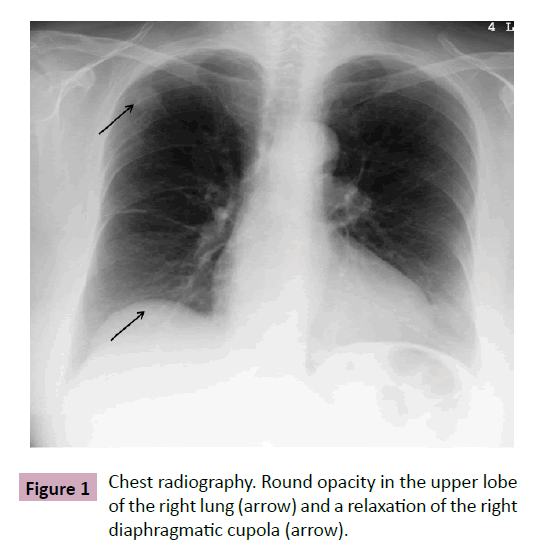
Figure 1 Chest radiography. Round opacity in the upper lobe of the right lung (arrow) and a relaxation of the right diaphragmatic cupola (arrow).
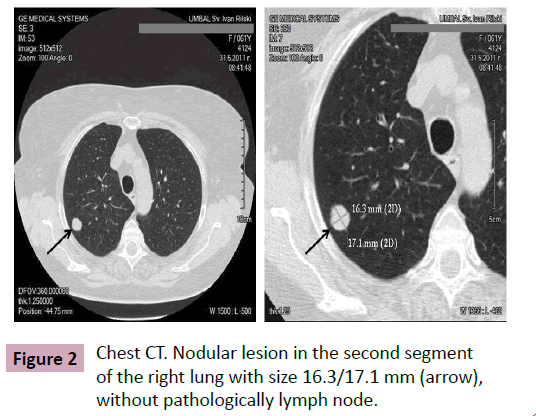
Figure 2 Chest CT. Nodular lesion in the second segment of the right lung with size 16.3/17.1 mm (arrow), without pathologically lymph node.
Bronchoscopy was not performed in this case because of the small dimension and peripheral location of the lesion. The lung biopsy is taken by video-assisted thoracic surgery besides of perifferal location of the lesion. The histological diagnosis, according to WHO’s classification of lung tumors [5], was small cell lung carcinoma (SCLC). Typical signs, identified by routine staining with hematoxylin and eozin, were the presence of small cells with scant cytoplasm, unclear cellular borders, finely granular nuclear chromatin and the absence/presence of nucleoli (Figure 3).
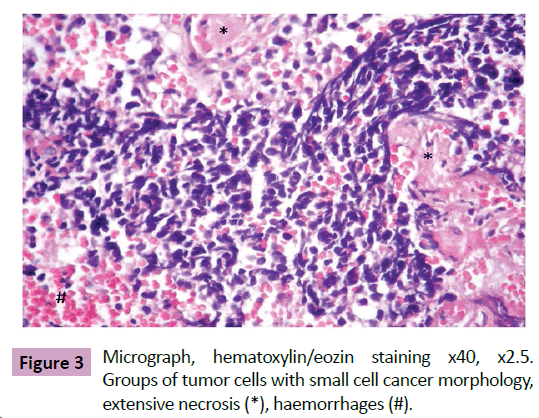
Figure 3 Micrograph, hematoxylin/eozin staining x40, x2.5. Groups of tumor cells with small cell cancer morphology, extensive necrosis (*), haemorrhages (#).
In this case the immunohistochemical expression of Cytokeratin, TTF-1, and Ki-67 was examined. Cytokeratin (Figure 4?) was positive in 90% of the tumor cells, which proved the epithelial origin of this cancer. TTF-1 was expressed in 100% of the tumor cells. Ki-67 (Figure 4b) proliferative index was 62%, showing the percentage of tumor cells in active process of division. According to clinical and pathological data the tumor was classified as T1aN0M0, stage IA. After diagnosis chemotherapy was started. The patient was followed for 10 months and had no signs of dermatomyositis.
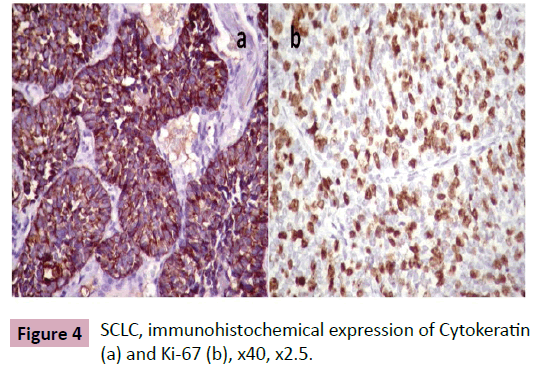
Figure 4 SCLC, immunohistochemical expression of Cytokeratin (a) and Ki-67 (b),40, 2.5.
Case 2
A 63 year old woman, with a 5-month history of progressive proximal muscle weakness, arthritis of the proximal interphalangeal joints (PIP), metacarpophalangeal joints (MIP), t°C to 37.9°C, weight reduction was admitted in August 2009 at the Rheumatology Clinic. Muscle symptoms were accompanied by skin rash. Her physical examination showed 2/5 muscle strength in the upper and lower extremities; erythema over the neck, heliotrope rash, erythema and fissuring of the lateral and palmar digital skin pads. Laboratory data showed: CPK 7055 U/l (normal 24-195 U/l), C-reactive protein 7.9 g/l (normal <6 g/l), increased levels of erythrocytes sedimentation rate (70 mm), negative myositis-specific and myositis associated antibodies, CYFRA 21-1 6.09 (normal <3.3), CEA 7.25 (normal <3.4), CA125 64.6 (normal <35).
The chest radiography revealed a nodular opacity, 3 cm in diameter in right upper lobe.
The chest CT confirmed the presence of a nodular heterodense formation with size 27 mm in the second and in the third right lung segments, but also revealed multiple bilateral asymmetric lesions, with no evidence of pathologically enlarged mediastinal lymph nodes.
The CT of the abdomen showed some hypodense lesions in the liver, 3 mm in diameter.
Diagnostic excision of the right lung was carried out at the end of September 2009. Macroscopically on the lung surface many granular formations with varying size were found. The diagnosis was made on tissue sections routinely stained with hematoxylin/eozin - combined non-small cell lung carcinoma consisted of squamous cell lung carcinoma with adenocarcinoma (30%), mainly papillary subtype (Figure 5a and 5b). Immunohistochemical expression of Cytokeratin, TTF-1, and Ki-67 was examined. Cytokeratin (Figure 6a) was positive in 100% of the tumor cells. TTF-1 (Figure 6b) was positive in 100% of the adenocarcinoma cells and in 70% of the squamous carcinoma cells. Ki-67 proliferative index was 65%.
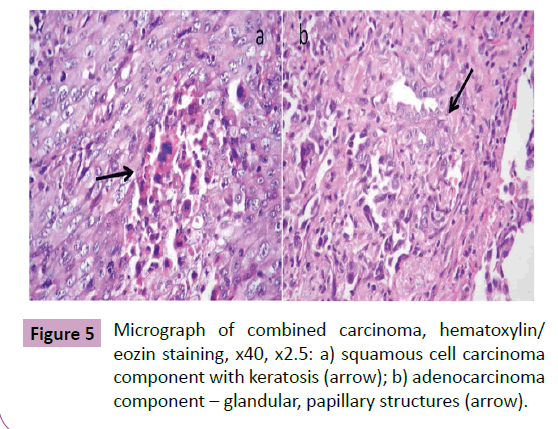
Figure 5 Micrograph of combined carcinoma, hematoxylin/ eozin staining, x40, x2.5: °) squamous cell carcinoma component with keratosis (arrow); b) adenocarcinoma component – glandular, papillary structures (arrow).
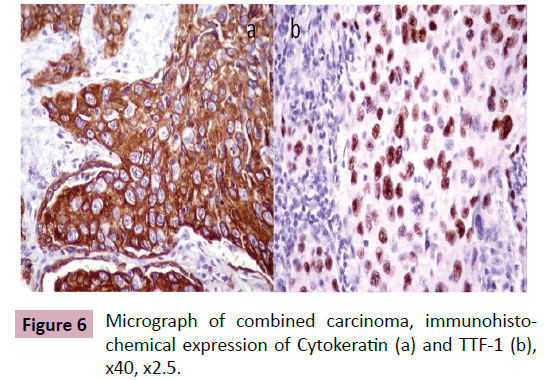
Figure 6 Micrograph of combined carcinoma, immunohistochemical expression of Cytokeratin (a) and TTF-1 (b), 40, 2.5.
The final diagnosis was combined carcinoma - squamous cell carcinoma with adenocarcinoma.
The skin/muscle biopsy wasn’t made because of patient’s refusal. After diagnosis chemotherapy was started but the patient died several months later.
Discussion and Conlusion
Dermatomyositis (DM) is a connective tissue disease, characterized by proximal muscle weakness, typical skin rash, creatine phosphokinase (CPK) elevation, electromyographic abnormalities and inflammatory lesions on muscle biopsy [1]. In pateints with DM, wtihout considerable therapeutic effects, in differential diagnosis have to discuss:
1. Dermatomyositis, primary drug resistant.
2. Dermatomyositis, associated with other connective tissue disease.
3. Dermatomyositis and infection.
4. Paraneoplastic dermatomyositis.
In adults with DM the most important feature is the increased incidence of malignancies. Several authors have reported coexistence of DM with various cancers (lung, stomach, colon, ovary cancer, non-Hodgkin lymphoma) [2-4]. Dermatomyositis can develop as a paraneoplastic syndrome – constellation of signs and symptoms, that are unrelated to the local effects of the primary tumor or its metastases and can present as the first sign of malignancy [5-7]. The prevalence of paraneoplastic dermatomyositis ranges from 6% to 45% of all cases with DM 2, 3. An increased cancer risk was found in female patients who were older than 50 years [8,9], as was observed in the two presented cases – two women, respectively 61 and 63 years old. In Bulgarian population, Durmichev diagnosed lung cancer in 25% of cases with paraneoplastic dermatomyositis [10]. The small cell lung carcinoma and the squamous cell lung carcinoma are the most common lung cancer types associated with DM. Other histopathological types – adenocarcinoma, carcinoid, combined carcinoma - are found more rarely in patients with tumorassociated myositis [11,12].
We present two cases of DM associated with lung cancer with different histopathological characteristics – respectively small cell lung carcinoma and combined carcinoma. The diagnosis DM was based on the criteria of Bohan and Peter including symmetrical proximal muscle weakness, increased serum muscle enzymes, electromyography abnormalities, typical histologic findings on muscle biopsy, and characteristic dermatologic manifestations [13,14]. DM preceded the occurrence of the malignancy by some months, respectively in the first case – by 10 months, in the second – by 6 months. DM can develop as a paraneoplastic phenomenon and indicates the presence of different tumor types, as DM can be found in diverse stages of development of the malignancies [15]. The first clinical case presented DM associated with early stage small cell lung carcinoma, characterized with normal levels of CPK, perivascular mononuclear inflammation and perifascicular fibrosis in muscle biopsy, and improvement of corticosteroid treatment. The other clinical case presented DM associated with advanced stage combined carcinoma with hematogenic metastases, characterized with increased of CPK over 7000 U/l, heliotrope rash, negative results for antibodies and resistance to corticosteroid therapy.
The diagnosis of DM urges the need to screen the patient with the help of anamnesis, physical examination, imaging, laboratory findings and biopsy findings. The paraneoplastic DM can be the first manifestation of a cancer process and that’s the reason for active search for cancer to find it earlier, when the treatment is more successful.
References
- Przybylski G, Jarzemska A, Czerniak J, Siemiatkowska K, Gadzinska A, et al. (2008) A case report of a patient with dermatomyositis as a prodromal sign of lung cancer. Polskie archiwum medycyny wewnetrznej 118: 143-146.
- Briemberg H, et Amato ? (2003) Dermatomyositis and polymyositis. Curr TreatOptions Neurol 5: 349-356.
- HillCL, Zhang Y,Sigurgeirsson B (2001) Frequency of specific cancer types in dermatomyositis and polymyositis: a population-based study. Lancet 357: 96-100.
- Grace JT, Dao TL (2006) Dermatomyositis in cancer: A possible etiological mechanism. Cancer 12: 648-650.
- Gabrilovich M, Raza M, Dolan S, Raza T (2006) Paraneoplastic polymyositis associated with squamous cell carcinoma of the lung. Chest 129: 1721-1723.
- Baer A (2011) Paraneoplastic muscle disease. Rheum Dis Clin North America 37: 185-200.
- Fam A (2000) Paraneoplastic rheumatic syndromes. Best Practice&Res Clin Rheum 14: 515-533.
- Travis W, Brambila E, Muler-Hermelink H, Harris C (2004) Pathology and Genetics: Tumours of the lung, pleura, thymus and heart. Lyon: IARC.
- Abu-Shakra M, Buskila D, Ehrenfeld M, Conrad K, Shoenfeld Y (2001) Cancer and autoimmunity: autoimmune and rheumatic features in patients with malignancies. Ann Rheum Dis 60: 433-441.
- Durmichev L (2002) Dermatomyositis – Current aspects. pp: 23-24.
- Schulman P, Kerr L, Spiera H (1991) A reexamination of the relationship between myositis and malignancy. J Rheumatol 18: 1689-1692.
- Weismann K (2000) Skin disorders as markers of internal disease. Paraneoplastic dermatoses: Ugeskr Laeger 162: 6834-6839.
- Bohan A, Peter JB (1975) Polymyositis and dermatomyositis (First of two parts). N Eng J Med 292: 344-347.
- Bohan A, Peter JB (1975) Polymyositis and dermatomyositis (Second of two parts). N Eng J Med 292: 403-407.
- Airio A, Pukkala E, Isomaki H(1995) Elevated cancer incidence in patients with dermatomyositis: a population based study. J Rheumatol 22: 1300-1303.







